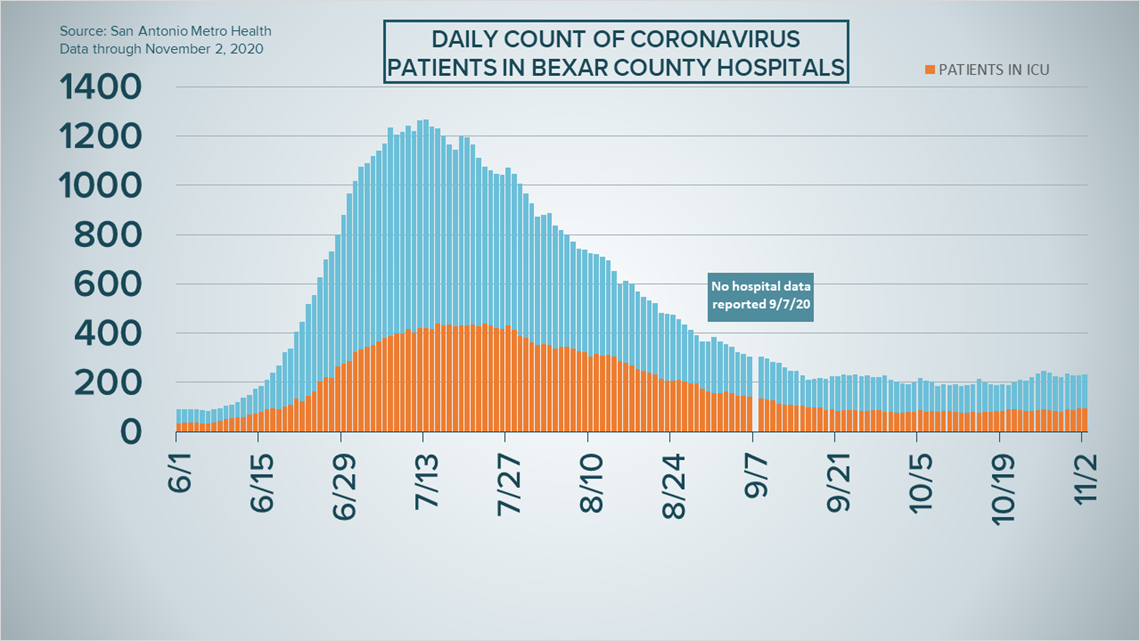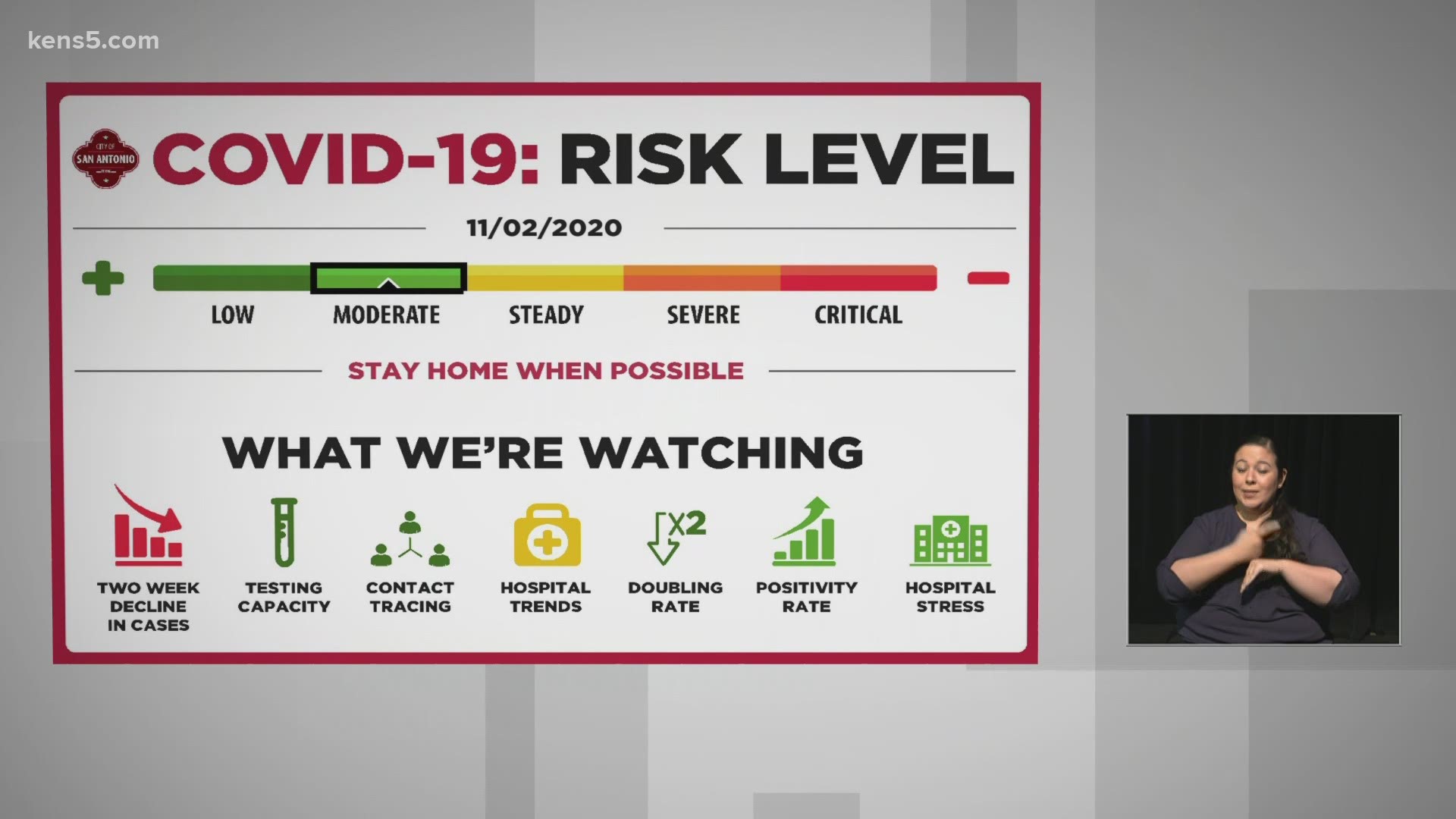SAN ANTONIO — We're tracking the latest numbers from the coronavirus pandemic in San Antonio and across Texas. Here are the latest numbers reported by Bexar and surrounding counties:
- Bexar County: 167 new cases were reported Monday, bringing the total number of cases for the county to 66,231. No new deaths also reported; the death toll remains at 1,260.
- Comal County: The county reported 15 new COVID-19 cases Monday morning as well as five backlogged cases added to county totals. No new virus-related deaths were reported. There have been a total of 3,796 cases of COVID-19 in the county – including 2,884 lab-confirmed cases – while 120 county residents have died. County officials say there are 131 active coronavirus cases, and 3,545 residents are considered recovered.
- Hays County: Officials in Hays County on Monday reported 44 new cases in the county and one additional virus-related death. As of Monday, there are a total of 6,176 lab-confirmed cases in the county (304 of which are active), while the death toll rose to 88. 5,784 residents have recovered from the virus.
How Bexar County is trending
We've tracked how many coronavirus cases have been confirmed in Bexar County from the time officials began reporting cases in March 2020. The graphic below shows the number of cases since June and charts those daily case numbers along a 7-day moving average to provide a more accurate picture of the overall coronavirus case curve in our area and the direction we're trending amid the pandemic.
On Monday, San Antonio Mayor Ron Nirenberg reported an additional 167 novel coronavirus cases for Bexar County. There have been at least 66,231 COVID-19 infections in our area during the ongoing pandemic.
The death toll in Bexar County remained at 1,260 after Nirenberg reported no new deaths from COVID-19 complications.


Hospitalization figures remained fairly stable on Monday, with a current total of 233 patients in local hospitals, a rise of six since Sunday. The number of patients using ventilators (49) and the number of patients in intensive care (96) also increased Monday.


Mayor Nirenberg noted two key risk indicators that were trending in the wrong direction in the last week. Bexar County saw an increase in cases over the last 14 days that started in mid-October. The county's positivity rate jumped almost a full percentage point in the last week, to 7.7%. Bexar County remains in the "moderate" zone of Metro Health's COVID-19 risk level indicator.
Coronavirus in Texas
The number of Texans who have tested positive for the coronavirus since the pandemic began grew by 4,402 on Monday, according to the Texas Department of State Health Services.
3,982 of those are new diagnoses over the last 24 hours, while another 420 cases stem from a number of backlogs in several counties. More details can be found at the top of this page.


The state surpassed 900,000 COVID-19 infections on Saturday, just 18 days after reaching 800,000 as the virus's spread quickens in the Lone Star State. As of Monday, at least 909,257 Texans have contracted COVID-19.
State health authorities also reported 20 additional virus-related deaths on Monday. At least 18,097 Texans have passed away from COVID-19 complications.
After COVID-19-related hospitalizations in Texas dropped slightly over the weekend, 5,770 Texans are currently receiving treatment for COVID-19 symptoms—79 more patients overall than on Sunday. Just 959 ICU beds are currently available statewide.
October saw a reversal of the previous two months' positive trends pertaining to the COVID-19 situation in Texas, including lower hospital admissions and case numbers. October ended with 79% more current hospitalizations than on Oct. 1. Health officials warn that the state is currently in another surge. Experts attribute the spike in COVID-19 numbers to "pandemic fatigue."
The state estimates that 782,006 Texans have recovered, while 102,769 Texans remain ill with COVID-19.
Meanwhile, the latest update from the Texas Education Agency showed that there have been 26,127 cumulative cases among staff and students across the state through Oct. 25. More information can be found here.
The TEA releases new data on school cases every Thursday.
Latest Coronavirus Headlines
- Hospitals competing for nurses as US coronavirus cases surge
- Families, day cares feel strain of new COVID-19 health rules
- Large crowds spotted on Sixth Street in Downtown Austin on Halloween night
- Coronavirus surge could speed up vaccine development
- US manufacturing activity at highest levels in two years
- Crushed by the coronavirus, 2 mall operators file for bankruptcy
- President Trump suggests he might be firing Dr. Fauci after election
Coronavirus symptoms
The symptoms of coronavirus can be similar to the flu or a bad cold. Symptoms include fever or chills, cough, shortness of breath or difficulty breathing, fatigue, muscle or body aches, headache, new loss of taste or smell sore throat, congestion or runny nose, nausea or vomiting and diarrhea, according to the Centers for Disease Control.
Most healthy people will have mild symptoms. A study of more than 72,000 patients by the Centers for Disease Control in China showed 80 percent of the cases there were mild.
But infections can cause pneumonia, severe acute respiratory syndrome, kidney failure, and even death, according to the World Health Organization. Older people with underlying health conditions are most at risk.
But infections can cause pneumonia, severe acute respiratory syndrome, kidney failure, and even death, according to the World Health Organization. Older people with underlying health conditions are most at risk.
Experts determined there was consistent evidence these conditions increase a person's risk, regardless of age:
- Chronic kidney disease
- COPD (chronic obstructive pulmonary disease)
- Obesity (BMI of 30 or higher)
- Immunocompromised state (weakened immune system) from solid organ transplant
- Serious heart conditions, such as heart failure, coronary artery disease, or cardiomyopathies
- Sickle cell disease
- Type 2 diabetes
The CDC believes symptoms may appear anywhere from two to 14 days after being exposed.
Human coronaviruses are usually spread...
- Between people who are in close contact with one another (within about 6 feet).
- Through respiratory droplets produced when an infected person coughs, sneezes or talks. These droplets can land in the mouths or noses of people who are nearby or possibly be inhaled into the lungs.
- Some recent studies have suggested that COVID-19 may be spread by people who are not showing symptoms.
Help stop the spread of coronavirus
- Stay home when you are sick.
- Eat and sleep separately from your family members
- Use different utensils and dishes
- Cover your cough or sneeze with your arm, not your hand.
- If you use a tissue, throw it in the trash.

